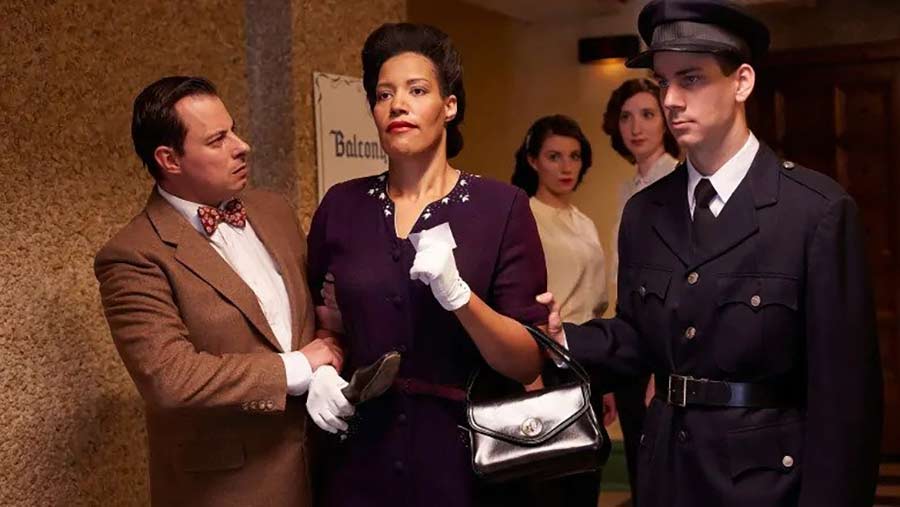Canada the Story of Us – New Identity (1946 – 1970): Post WWII, marginalized Canadians fight for their rights. Canada experiences a boom time after the war, but not all are happy with the status quo. They seek to reshape the country and challenge dark legacies of injustice. The circle of Confederation grows and Canada emerges as a complex and cosmopolitan nation on the world stage.
Over 10 hours, the drama-documentary tells the extraordinary tale of some of the people, places and events that shaped Canada — stories of change makers and rule breakers, dreamers and visionaries, scientists and entrepreneurs who forged a nation in a vast and harsh land.
Canada the Story of Us – New Identity (1946 – 1970)
Joey Smallwood convinces Newfoundlanders to join Confederation (1949)
Crippled by debt and a crumbling government, Newfoundland stands at a crossroads: does it join Britain or become a country unto itself? Newfoundland’s upper class are pushing hard for independence. Amid the debate, Joey Smallwood bursts onto the scene, proposing a third option: join Canada. He’s met with great resistance and his dramatic campaign leads to several outright brawls.
Smallwood’s vision, passion and incredible hard work tip the referendum vote barely in favour of joining Canada – and the benefits are massive: roads, schools, hospitals, infrastructure, industrial development and greater equity. It’s a defining moment for Newfoundland and for Canada.
Viola Desmond fights segregation in Nova Scotia (1946) – Canada the Story of Us
In November 1946, Viola Desmond decides to take in a movie while she waits for her car to be fixed. She misses the movie, but finds a place in Canadian history.
Desmond is black. The manager of the Roseland Theatre in New Glasgow, NS is an ardent segregationist. When Viola is told that because of the colour of her skin, she’ll have to move from the main floor – which was reserved for whites only – to the balcony, she ignores the request and returns to her main floor seat.
The theatre manager calls the police, who drag her out of the theatre and throw her in a cell for the night. She is later charged in court for allegedly refusing to pay a one-cent amusement tax. She gets no justice in her subsequent legal challenges, but the event mobilizes the African-Canadian community, which turns its energy toward challenging racial discrimination more widely.
First Nations activists occupy Blue Quills residential school (1970)
As the Canadian government prepares to close the Blue Quills residential school near St. Paul, AB, community members from the surrounding First Nations occupy it. They demand the government hand control of it over to them, rather than close it. After three days of negotiations, the government relents, approves their takeover of the school and Blue Quills becomes the first Indigenous administered school.
The Rocket Richard Riots & the Quiet Revolution (1955) – Canada the Story of Us
In a 1955 game against the Boston Bruins, Montreal Canadiens’ star, Maurice Richard, is hit in the head with a stick. Richard retaliates, throwing wild punches and hitting not only Boston players, but also an official. When NHL President Clarence Campbell suspends Richard for the rest of the season, it becomes a flashpoint for linguistic tensions in Quebec. Riots break out in Montreal. Francophone Quebecers see the suspension as the Anglo suppression of French identity. Many will cite the Richard Riots as the starting point of Quebec francophones’ fight to be “maîtres chez nous” — “masters on our own home.”
The Quiet Revolution gets loud (1955-1970)
On Oct. 5, 1970, the Liberation cell of the Front de libération du Québec (FLQ) kidnaps British Trade Minister James Cross from his Montreal home. They demand a ransom, the release of jailed FLQ members and the broadcast of their manifesto on the CBC. Five days later, members of the FLQ’s Chernier cell kidnap Quebec Labour Minister and Vice Premier Pierre Laporte from the front lawn of his home in the Montreal suburb of Saint-Lambert.
Prime Minister Pierre Elliott Trudeau controversially invokes the War Measures Act to deal with the crisis, flooding the streets of Montreal with soldiers and giving police the freedom to arrest and detain without a warrant. By December, Cross is freed. Laporte is less fortunate; he is killed by his captors.

Pingback: Canada the Story of Us – The Canadian Experiment